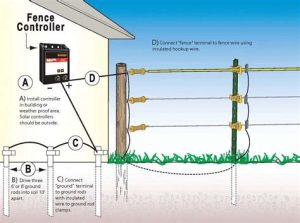Learn how to navigate local fence regulations, check property lines, obtain permits, comply with restrictions, and avoid legal issues in your fencing project.Installing a fence can enhance both the aesthetic appeal and security of your property, but many homeowners overlook a critical step: checking local regulations. Understanding whether you need a permit for your fence installation is crucial to avoid potential legal and financial pitfalls. Each municipality has its own set of rules governing property lines, boundary definitions, and specific requirements for fences. In this blog post, we’ll explore these regulations, guide you on how to check your property lines, and outline the importance of obtaining necessary permits. We’ll also delve into the restrictions you may face regarding height and materials, ensuring you stay compliant. By being informed, you can prevent misunderstandings and create a backyard space you’ll love without the risk of costly fines or disputes with neighbors. Let’s get started on your journey to a new fence!
Understanding local fence regulations
When considering the installation of a fence on your property, it is crucial to understand local fence regulations. These regulations vary significantly from one municipality to another and can impact the design, height, and materials used for your fence. Failing to comply with these regulations can lead to complications, including potential fines and the removal of the fence.
Many localities have specific guidelines that govern how close a fence can be to the property line. For instance, some towns might require that a fence must be set back a certain distance from the property line, while others may have no such restrictions. It’s essential to check with your local zoning office or visit their website to obtain the most current regulations pertaining to fence installation.
Additionally, some areas have rules regarding the aesthetic aspects of fences, such as color or style, particularly in designated historic districts. Understanding these rules not only ensures that you stay compliant but also can help improve the overall appearance and value of your property.
Checking property line and boundaries
When considering the installation of a fence, one of the most critical steps is checking your property line and boundaries. Understanding where your property begins and ends can prevent disputes with neighbors and legal issues in the future.
To accurately check your property lines, you may want to start with reviewing your property deed. This document typically includes a description of your property boundaries. You can also refer to a surveyor’s plat or get in touch with a local land surveyor who can provide precise measurements.
Additionally, you can visit your local government’s offices or websites, which may have detailed maps and records. Many municipalities have resources that outline property lines, including tax maps and zoning maps.
Obtaining necessary permits and approvals
When planning to install a fence on your property line, one of the most crucial steps is to understand whether you need to obtain the necessary permits and approvals. The requirements can vary significantly depending on your local laws and regulations, so it’s vital to check with your local government or zoning office.
Typically, municipalities require permits to ensure that the installation of fences adheres to local building codes and zoning laws. This may involve submitting a proposed plan that outlines the dimensions and location of your planned fence. Some areas may also have specific design guidelines based on the neighborhood’s aesthetic or historical significance.
Failing to acquire the necessary permits can lead to serious consequences. This might include having to dismantle and remove the fence, incurring fines, or even facing legal disputes with neighbors. Therefore, it is advisable to do your homework and ensure all approvals are in place before you break ground on your new fence project.
Complying with height and material restrictions
When planning to install a fence on your property line, one of the most crucial aspects to consider is height and material restrictions. Many municipalities have specific regulations that dictate how tall a fence can be and what materials can be used for its construction. These rules are designed to ensure that fences enhance rather than detract from the community’s aesthetic and safety.
Typically, residential fence height limitations vary by location, often ranging from 4 to 6 feet in the backyard and sometimes lower in the front yard. It’s essential to check with your local zoning office to find out what is permissible in your area. In addition to height restrictions, certain materials may be prohibited or regulated due to their appearance, durability, or environmental impact. Common fence materials like wood, vinyl, and chain link may all have different guidelines associated with them.
Failing to comply with these height and material restrictions can lead not only to potential fines but may also necessitate the removal of the fence if it does not meet specified guidelines.
Avoiding potential legal and financial consequences
When considering the installation of a fence on your property line, it is essential to be aware of the potential legal and financial consequences that may arise. Fencing disputes can lead to misunderstandings with neighbors and even costly legal battles if not handled correctly. Understanding your responsibilities as a property owner can prevent these issues.
One major risk is encroachment, where the fence may unintentionally go beyond your property boundary. This can lead to conflicts with neighbors and may require you to remove or relocate the fence. To avoid this, it’s crucial to ensure you know the exact property lines and comply with local zoning laws.
| Potential Issue | Consequence |
|---|---|
| Fence encroaches on neighbor’s property | Legal disputes and costs for removal |
| Failure to obtain permits | Fines and needing to remove the fence |
| Non-compliance with local regulations | Legal fees and potential property devaluation |
To further safeguard your investment, it’s recommended that you consult local fence regulations and even consider speaking to a legal expert in property law. This way, you can navigate the complexities of local regulations effectively, ensuring that your property is protected and minimizing any financial risks related to fence installation.
Frequently Asked Questions
What is the general requirement for installing a fence?
Most municipalities require a permit for installing a fence, especially if it exceeds certain height regulations.
How can I find out if I need a permit for my fence?
Check your local zoning laws or contact your city or county’s building department for specific requirements.
Are there any exceptions to the permit requirement?
Yes, some jurisdictions may have exceptions for small fences or temporary barriers, but it’s best to verify with local regulations.
What information is typically required when applying for a fence permit?
You may need to provide a site plan, details about the fence materials, height, and location relative to property lines.
What can happen if I install a fence without a permit?
You may face fines, be required to remove the fence, or make modifications to comply with zoning laws.
How long does it usually take to get a fence permit?
The processing time varies by location but generally ranges from a few days to several weeks, depending on the local governmental procedures.
What are some best practices for installing a fence legally?
Always check local laws, mark property lines, discuss plans with neighbors, and apply for the necessary permits before starting the installation.





